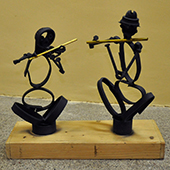Design Resource
Scrap Metal Statue - Ahmednagar, Maharashtra
Sculpture Art
by
Prof. Bibhudutta Baraland Srikanth B
Since ancient age, iron has been worked or wrought to make a range of materials that differ extensively from the counterparts of gold or silver in their attributes and qualities. Tracing back to the history, prevalence of iron objects was comparatively low due to its property of easy corroding. Cast iron is the type where melted iron is poured into a mold and allowed to cool to achieve a particular shape, thus making it different from wrought iron which works on heated cast iron to be shaped with tools. The Cast iron is believed to be invented in China in the 5th century BC and was majorly used to make plowshares, pots, weapons, and pagodas.
Scrap is a leftover obtained after a greater portion of something has been used, thus qualifying itself to be recyclable material. It is largely found throbbing around the manufacturing of vehicles, buildings, and house old items. This with a socially responsible advantage helps support organizations that stand for recycling and environmental protection. This practice of recycling has a rich history that started in 400 BC, where utility objects were made out of recycled glass. Remains of this tradition were first found from the sites of Sagalassos, present-day Turkey. Romans also traded high-priced statues made from melted brass coins. Some legends underline the method of turning jewels and coins into fighting weapons during wars when the kingdom stands in high need of more armaments.
Welding is the method of joining or fusing two metals into one by heating. Since several millennia artisans have been using the technique for making small boxes and jewels, especially in the parts of Europe, the Middle East, and Egypt. Forge welding was extensively used until the middle ages, later with the invention of the acetylene torch in 1900, arc welding came into existence. When coated electrodes were developed, shield welding also known as stick welding became popular, this produces lesser impurities compared to other welding techniques. The technology behind welding evolved further during the world wars, thus now we have around 90 different types of welding processes existing. Coming to scrap metal statues or welded sculptures, this craft was developed by Spain-based Julio Gonzalez, who while running his family metalsmith business, created this art form. Inspired by its success, many artists around India took up this profession and one among them is Mr. Balaji Vallal. He is a well-trained sculpting artisan who runs his art workshop in Ahmednagar, Maharashtra. At the center, sculptures of clay, fiber casting, metal spoon birds, and scrap metal statues are developed, which are widely exhibited as well as sold to customers spread widely. He has been felicitated with awards and mementos for his contribution to his area of expertise. Some of his awards and exhibitions are listed below:
Awards:
1. Shilok Kala Academy (1st place) Aurangabad, 2009, 2010 and 2012.
2. Annual Art Exhibition (2nd place) Pune, 2005, 2006 and 2007.
3. State Art (2nd place) Mumbai, 2007.
4. Smruthi Gandhi Art Competition, Pune, 2002.
Participation:
1. Shilok Kala Academy, Aurangabad, 2013, 2014.
2. Stat Art Exhibition, Mumbai, 2007, 2013.
3. Bombay Art Society, Mumbai, 2007, 2008.
4. National Young Artist Camp, Pune, 2006.
Group Shows:
1. Thulsi Art, Pune, 2014.
2. Aakar Kala Exhibition, Ahmednagar, 2013.
3. India Art Festival, Mumbai, 2012.
4. 130th Monsoon Art Show, Mumbai, 2007.
5. Shilp Mahotsav, Pune, 2006.





